Self-Compacting High-Strength Textile-Reinforced Concrete Using Sea Sand and Sea Water
Abstract
1. Introduction
1.1. Research Framework
1.2. Problem Statement
1.3. The Ocean as a Source of Basic Concrete Constituents
2. Materials and Methods
- -
- compressive strength at age of 3, 7 and 28 days according to the methodology in [54], load application rate 2.45 kN/s;
- -
- flexural strength at age of 3, 7 and 28 days according to the methodology in [54] (three-point load schema), load application rate 0.05 kN/s;
- -
- modulus of elasticity at the age of 28 days [55];
- -
- drying shrinkage determined with linear method [56];
- -
- water absorption: the samples were initially dried for 24 h at 105 °C, then weighed. Afterward, the samples were placed in a water bath for 48 h in such a way that the water level was 5 cm above the top of the samples. The samples were then taken out from the water bath, lightly wiped with a dry cloth and weighed. The water absorption was determined in %, as the mass difference between a dry and a water-saturated sample;
- -
- uniaxial tensile strength test [57], load rate 1 mm/min.
3. Test Results and Discussion
3.1. Compressive Strength and Water Absorption
3.2. Flexural Strength
3.3. Elastic Modulus
3.4. Drying Shrinkage
3.5. Textile-Reinforced Concrete—Uniaxial Tensile Test
3.6. CO2 Emissions of SCHSC
4. Conclusions and Outlook
- -
- the flowability of the sea concrete was more viscous than the control concrete because of the amount of sea shells, which are contained in the sea sand, and because of the salt in the sea water, which accelerated the hydration. Therefore, a higher content of superplasticizer for the concrete mixture with sea water and sea sand can be expected. Additionally, the air content test confirmed that, although self-compacting concrete was produced, which usually has a higher air content, in this case, it was below the limit of 5–6% and had no negative influence on the pore structure;
- -
- the use of sea sand and sea water for the production of SCHSC based on slag cement makes it possible to produce concretes with comparable mechanical properties while significantly improving the life cycle assessment. At the age of 3 days, the compressive strength of the sea concrete composition was 37.3 MPa, which was around 10.9 MPa lower than the compressive strength of the control concrete composition at 48.2 MPa, due to the slower hydration rate of the slag cement. However, this cannot be considered a negative effect because, in new construction, early strength is not paramount. It was experimentally established that at the age of 28 days, sea concrete had a compressive strength of 72 MPa, which corresponds to the concrete grade of C45/55. The strength of the control concrete was 69.4 MPa, which corresponds to the concrete grade of C40/45. The flexural strength at the age of 3, 7, 28 days of sea concrete was slightly lower (6.1 MPa, 7.7 MPa, 9.2 MPa) than the flexural strength (7.1 MPa, 7.6 MPa, 11.1 MPa) of control concrete due to the weak surface contact between the shells and the cement matrix;
- -
- after 28 days, the modulus of elasticity for the sea concrete showed a higher value of 39.1 GPa in comparison to the control concrete value of 38.9 GPa, which showed that sea water had no effect on it;
- -
- the studies on durability in the form of drying shrinkage show that at the early ages (3 days), the sea concrete shrinkage deformations exceed 122% with 0.6 mm/m in comparison to the control concrete. This is explained by the fact that, with the use of sea water, the pore structure is refined, and the capillary pores (>100 nm) are reduced [18]. Due to their size, the capillary pores have a faster and better water transport. At the same time, the number of fine gel pores increases, but they can hold the water for a very long time and cause larger shrinkage deformations [80]. After 56 days, the shrinkage deformations between the sea concrete (1.07 mm/m) and the control concrete (0.97 mm/m) had a fading character;
- -
- the combination effect of sea concrete as an SCHSC with textile reinforcement on the tensile strength (3.6 MPa) shows equal results to the control concrete (3.3 MPa) with a slightly increasing trend. The obtained data on the performance of textile-reinforced concrete based on sea and control concrete matrices show the same result.
- -
- the raw materials used for the production of concrete in our experiment can be recommended for the construction of facilities near the sea coast, which makes it possible to obtain SCHSC. It is important to note that by using slag cement in the production of textile-reinforced structures, CO2 emissions can be significantly reduced. The ability to use sea sand as an aggregate also eliminates the need to deliver this material to the construction site, which further reduces CO2 emissions. Figure 13 shows that the decrease in CO2 emissions for 1 m3 of concrete would be more than 90% in total. In addition, the use of textile-reinforced concrete allows us to reduce the cross-sectional thickness of structural elements, which makes it possible to reduce the material consumption and bypass corrosion of steel reinforcement due to sea sand/water.
Author Contributions
Funding
Institutional Review Board Statement
Informed Consent Statement
Data Availability Statement
Acknowledgments
Conflicts of Interest
References
- Available online: https://gccassociation.org/concretefuture/cement-concrete-around-the-world/ (accessed on 21 May 2023).
- Hewlett, P.C.; Liska, M. Lea’s Chemistry of Cement and Concrete, 5th ed.; Butterworth-Heinemann: Oxford, UK, 2017; 858p. [Google Scholar]
- Taylor, H. Cement Chemistry; Thomas Telford: London, UK, 1997; 459p. [Google Scholar]
- Available online: https://www.un.org/esa/sustdev/natlinfo/indicators/methodology_sheets/oceans_seas_coasts/pop_coastal_areas.pdf (accessed on 21 May 2023).
- United Nations Conference on Trade and Development. Review of Maritime Transport. 2021. Available online: https://unctad.org/system/files/official-document/rmt2021summary_en.pdf (accessed on 4 June 2023).
- United Nations World Tourism Organization. UNWTO Annual Report. 2016. Available online: https://sdgs.un.org/publications/unwto-annual-report-2016-18098 (accessed on 4 June 2023).
- Foti, E.; Musumeci, R.-E.; Stagnitti, M. Coastal Defence Techniques and Climate Change: A Review. Rend. Lincei Sci. Fis. Nat. 2020, 31, 123–138. [Google Scholar] [CrossRef]
- Burcharth, H.; Andersen, T.; Lara, J. Upgrade of Coastal Defence Structures against Increased Loadings Caused by Climate Change. A First Methodological Approach. Coast. Eng. 2014, 87, 112–121. [Google Scholar] [CrossRef]
- DIN EN 15978-10:2012; Sustainability of Construction Works. Assessment of Environmental Performance of Buildings. Calculation Method. Deutsches Institut für Normung: Berlin, Germany, 2012.
- Available online: https://www.ipcc.ch/report/ar6/wg1/ (accessed on 4 June 2023).
- ISO 14025:2006; Environmental Labels and Declarations. Type III Environmental Declarations. Principles and Procedures. Technical Committee: ISO/TC 207/SC 3 Environmental Labelling. ISO: Geneva, Switzerland, 2006.
- DIN EN 15804:2022-03; Sustainability of Construction Works. Environmental Product Declarations. Core Rules for the Product Category of Construction Products. Deutsches Institut für Normung: Berlin, Germany, 2022.
- Haist, M.; Bergmeister, K.; Curbach, M.; Forman, P.; Gaganelis, G.; Gerlach, J.; Mark, P.; Moffat, J.; Muller, C.; Muller, H.-S.; et al. Nachhaltig konstruieren und bauen mit Beton (Sustainable construction and building with concrete). In Beton Kalender 2022: Nachhaltigkeit, Digitalisierung, Instandhaltung; Wiley: Hoboken, NJ, USA, 2022; pp. 421–531. [Google Scholar]
- Bilgeri, P.; Droll, K.; Ehrenberg, A.; Ehrlich, N.; Küchlin, D.; Liebig, E.; Müller, C.; Paatsch, A.; Peck, M.; Rendchen, K.; et al. CEM II- und CEM III/A-Zemente im Betonbau, Nachhaltige Lösungen für das Bauen mit Beton; Verein Deutscher Zementwerke e.V. Stand: Düsseldorf, Germany, 2008; 56p. [Google Scholar]
- Available online: https://www.vdz-online.de/fileadmin/wissensportal/publikationen/basiswissen/zement-merkblaetter/B1.pdf (accessed on 4 June 2023).
- Available online: https://unepgrid.ch/en/resource/2022SAND (accessed on 4 June 2023).
- Leal Filho, W.; Hunt, J.; Lingos, A.; Platje, J.; Vieira, L.-W.; Will, M.; Gavriletea, M.-D. The unsustainable use of sand: Reporting on a global problem. Sustainability 2021, 13, 3356. [Google Scholar] [CrossRef]
- Zhao, Y.; Hu, X.; Shi, C.; Zhang, Z.; Zhu, D. A Review on Seawater Sea-sand Concrete: Mixture Proportion, Hydration, Microstructure and Properties. Constr. Build. Mater. 2021, 295, 123602. [Google Scholar] [CrossRef]
- Sutton, G. Iris Sea Marine Aggregate Initiative (IMAGIN) Technical Synthesis Report. In Environment and Health Series; No. 36; Marine Institute: Cape D’Aguilar, Hong Kong, 2008; 66p. [Google Scholar]
- Available online: https://education.nationalgeographic.org/resource/earths-fresh-water/ (accessed on 4 June 2023).
- Miller, S.-A.; Horvath, A.; Monteiro, P.-J. Impacts of Booming Concrete Production on Water Resources Worldwide. Nat. Sustain. 2018, 1, 69–76. [Google Scholar] [CrossRef]
- Hamada, H.; Otsuki, N.; Nishida, T. Seawater in Concrete Mix; CRC Press: Boca Raton, FL, USA, 2021; 144p. [Google Scholar]
- Cui, M.; Mao, J.-Z.; Jia, D.-G.; Li, B. Experimental Study on Mechanical Properties of Marine Sand and Seawater concrete. In Proceedings of the 2014 International Conference on Mechanics and Civil Engineering, Wuhan, China, 13–14 December 2014; pp. 106–111. [Google Scholar]
- Sidhardhan, S.; Jansi, S.; Meylin, J. Study on Sea Sand as a Partial Replacement for Fine Aggregate. J. Adv. Chem. 2017, 13, 6166–6171. [Google Scholar]
- Sanjaya, F.-A.; Wasono, S.-B.; Wulandari, D. Analysis of Use Sea Sand as a Fine Aggregate Replacement to Strong Press Concrete. Int. J. Eng. Sci. Inf. Technol. 2021, 1, 1–6. [Google Scholar] [CrossRef]
- Qiao, S.; Xiong, Z.; Li, Y.; Ye, Z.; He, S.; Li, L.; Zeng, Y. Mechanical Properties of Seawater Sea-Sand Concrete Exposed to Daily Temperature Variations. Buildings 2022, 12, 517. [Google Scholar] [CrossRef]
- Li, Q.; Lee, M.-G.; Che, G.; Kan, Y.-C.; Chiu, C.-T. Mechanical Properties and Corrosion Resistance of Cement Concrete Containing Sea Sand or Sea Water. Int. J. Appl. Sci. Eng. 2018, 15, 199–210. [Google Scholar]
- Liu, J.; Xie, W.; Yu, H.; Xiao, H.; Dong, S.; Yang, W. Design and Evaluation of an Ultrahigh-Strength Coral Aggregate Concrete for Maritime and Reef Engineering. Materials 2021, 14, 5871. [Google Scholar] [CrossRef]
- Jahani, M.; Shahnoori, S.; Moradi, S.; Ershadi, C. Cleaner Production Towards a Green Concrete; Multi-scale Experimental Study on Long-Term Performance of a Sustainable Modified-SWSSC. Am. J. Constr. Build. Mater. 2022, 6, 43–59. [Google Scholar]
- Katano, K.; Takeda, N.; Ishizeki, Y.; Iriya, K. Properties and Application of Concrete Made with Sea Water and Unwashed Sea Sand. In Proceedings of the 3rd International Conference on Sustainable Construction Materials and Technologies, Kyoto, Japan, 18–21 August 2013. [Google Scholar]
- Olutoge, F.A.; Modupeola, A.G. The Effect of Seawater on Shrinkage Properties of Concrete. Int. J. Res. Eng. Technol. 2014, 2, 1–12. [Google Scholar]
- Younis, A.; Ebead, U.; Suraneni, P.; Nanni, A. Fresh and Hardened Properties of Seawater-Mixed Concrete. Constr. Build. Mater. 2018, 190, 276–286. [Google Scholar] [CrossRef]
- Zhang, B.; Zhu, H.; Shah, K.-W.; Dong, Z.; Wu, J. Performance Evaluation and Microstructure Characterization of Seawater and Coral/Sea Sand Alkali-Activated Mortars. Constr. Build. Mater. 2020, 259, 120403. [Google Scholar] [CrossRef]
- Zhang, Z.; Sang, Z.; Zhang, L.; Ma, Z.; Zhang, Y. Experimental Research on Durability of Concrete Made by Seawater and Sea-Sand. Adv. Mater. Res. 2013, 641–642, 385–388. [Google Scholar] [CrossRef]
- DIN EN 206-1:2001; Concrete. Specification, Performance, Production and Conformity. Deutsches Institut für Normung: Berlin, Germany, 2001.
- Mahovec, J.; Reiterman, P. Influence of Aggressive Environment on the Tensile Properties of Textile Reinforced Concrete. Acta Polytech. 2018, 58, 245. [Google Scholar] [CrossRef]
- Alma‘aitah, M.; Ghiassi, B.; Dalalbashi, A. Durability of Textile-Reinforced Concrete: Existing Knowledge and Current Gaps. Appl. Sci. 2021, 11, 2771. [Google Scholar] [CrossRef]
- DIN EN 197-1:2011; Cement. Composition, Specifications and Conformity Criteria for Common Cements. Deutsches Institut für Normung: Berlin, Germany, 2011.
- Curbach, M.; Hegger, J.; Schladitz, F.; Tietze, M.; Lieboldt, M. Handbuch Carbonbeton: Einsatz Nichtmetallischer Bewehrung; John Wiley and Sons: Hoboken, NJ, USA, 2023; 596p. [Google Scholar]
- C3 Carbon Concrete Composite: Fragen und Antworten auf Carbonbeton. Available online: http://www.bauen-neu-denken.de/ (accessed on 27 June 2023).
- Beßling, M.; Orlowsky, J. Quantification of the Influence of Concrete Width per Fiber Strand on the Splitting Crack Failure of Textile Reinforced Concrete (TRC). Polymers 2022, 14, 489. [Google Scholar] [CrossRef]
- Langenbeck, A.-D.; Spyridis, P.; Beßling, M.; Orlowsky, J. Experimental Investigations of Power-Actuated Fastenings in TRC. Dev. Built Environ. 2023, 14, 100158. [Google Scholar] [CrossRef]
- Holschemacher, K.; Klug, I. Development of Self-Compacting Concretes for Textile-Reinforced Structural Members. In Proceedings of the 3rd International Conference on Structural Engineering, Mechanics and Computation, Cape Town, South Africa, 10–12 September 2007. [Google Scholar]
- Dvorkin, L.; Bordiuzhenko, O. Self-Compacting Concretes with the Polymer Admixture. J. Chem. Technol. Metall. 2023, 58, 44–52. [Google Scholar]
- Kirakevych, I.; Sanytsky, M.; Margal, I. Self-Compacting Concretes, which Hardening at Different Temperatures. Theory Build. Pract. 2020, 2, 107–112. [Google Scholar] [CrossRef]
- Gamil, Y.; Nilimaa, J.; Najeh, T.; Cwirzen, A. Formwork Pressure Prediction in Cast-in-Place Self-Compacting Concrete Using Deep Learning. Autom. Constr. 2023, 151, 104869. [Google Scholar] [CrossRef]
- Dehn, F.; Reintjes, K.-H.; Tauscher, F.; Maurer, R. Verwendung von Selbstverdichtendem Beton für Geneigte Brückenflächen. Beton Stahlbeton 2013, 97, 657–662. [Google Scholar] [CrossRef]
- DIN EN 933-1:2021; Tests for Geometrical Properties of Aggregates. Determination of Particle Size Distribution—Sieving Method. Deutsches Institut für Normung: Berlin, Germany, 2021.
- DIN EN 1097-6:2022; Testing Aggregates. Determination of Particle Density and Water Absorption. Deutsches Institut für Normung: Berlin, Germany, 2022.
- DIN EN 12390-2:2019; Testing Hardened Concrete. Making and Curing Specimens for Strength Tests. Deutsches Institut für Normung: Berlin, Germany, 2019.
- DIN EN 12350-8:2019; Testing Fresh Concrete. Slump-Flow Test. Deutsches Institut für Normung: Berlin, Germany, 2019.
- DIN EN 12350-6:2019; Testing Fresh Concrete. Density. Deutsches Institut für Normung: Berlin, Germany, 2019.
- DIN EN 12350-7:2022; Testing Fresh Concrete. Air Content—Pressure Methods. Deutsches Institut für Normung: Berlin, Germany, 2022.
- DIN EN 196-1:2016; Methods of Testing Cement. Determination of Strength. Deutsches Institut für Normung: Berlin, Germany, 2016.
- DIN EN 12390-13:2021; Testing Hardened Concrete. Determination of Secant Modulus of Elasticity in Compression. Deutsches Institut für Normung: Berlin, Germany, 2021.
- DIN EN 12390-16:2019; Testing Hardened Concrete. Determination of the Shrinkage of Concrete. Deutsches Institut für Normung: Berlin, Germany, 2019.
- Brameshuber, W. Recomendation of RILEM TC 232-TDT: Test Methods and Design of Textile Reinforced Concrete. Mater. Struct. 2016, 49, 4923–4927. [Google Scholar]
- Liu, W.; Cui, H.; Dong, Z.; Xing, F.; Zhang, H.; Lo, T.-Y. Carbonation of Concrete Made with Dredged Marine Sand and its Effect on Chloride Binding. Constr. Build. Mater. 2016, 120, 1–9. [Google Scholar] [CrossRef]
- Li, Q.; Geng, H.; Huang, Y.; Shui, Z. Chloride Resistance of Concrete with Metakaolin Addition and Seawater Mixing: A Comparative Study. Constr. Build. Mater. 2015, 101, 184–192. [Google Scholar] [CrossRef]
- Shi, Z.; Shui, Z.; Li, Q.; Geng, H. Combined Effect of Metakaolin and Sea Water on Performance and Microstructures of Concrete. Constr. Build. Mater. 2015, 74, 57–64. [Google Scholar] [CrossRef]
- Manikandan, R.; Revathi, S. Behavioral Study on Treated Sea Sand as a Fine Aggregate in Concrete. J. Adv. Civ. Eng. 2018, 4, 8–14. [Google Scholar] [CrossRef]
- He, S.; Jiao, C.; Niu, Y.; Li, S. Utilizing of Coral/Sea Sand as Aggregates in Environment-Friendly Marine Mortar: Physical Properties, Carbonation Resistance and Microstructure. Case Stud. Constr. Mater. 2022, 16, e00981. [Google Scholar] [CrossRef]
- Guo, M.; Hu, B.; Xing, F.; Zhou, X.; Sun, M.; Sui, L.; Zhou, Y. Characterization of the Mechanical Properties of Eco-Friendly Concrete Made with Untreated Sea Sand and Seawater Based on Statistical Analysis. Constr. Build. Mater. 2020, 234, 117339. [Google Scholar] [CrossRef]
- Bhuvaneswari, M.; Gunalan, P.; Manoj Babu, M.; Ajithkumar, S.; Manivel, K. Experimental Study on Partial Replacement of Sea Sand as Fine Aggregate in Concrete. Int. J. Sci. Eng. Res. 2018, 6, 3221–5687. [Google Scholar]
- Hasdemir, S.; Turgul, A.; Yilmaz, M. The Effect of Natural Sand Composition on Concrete Strength. Constr. Build. Mater. 2016, 112, 940–948. [Google Scholar] [CrossRef]
- Jose, T.; Mathew, B.; Johny, G.; Benny, M.-P.; Reji, S. Feasibility of Sea-Sand Sea-Water Concrete. Int. J. Eng. Res. Technol. 2019, 8, 18–25. [Google Scholar]
- Mahendran, H.; Godwin, K.; Gnana Selvan, T.; Murugan, M. Experimental Study on Concrete using Sea Sand as Fine Aggregate. Int. J. Sci. Eng. Res. 2016, 7, 49–52. [Google Scholar]
- Li, Y.-L.; Zhao, X.-L.; Raman, S. Durability of Seawater and Sea Sand Concrete and Seawater and Sea Sand Concrete-Filled Fibre-Reinforced Polymer/Stainless Steel Tubular Stub Columns. Adv. Struct. Eng. 2020, 24, 1074–1089. [Google Scholar] [CrossRef]
- Orlowsky, J.; Beßling, M.; Kryzhanovskyi, V. Prospects for the Use of Textile-Reinforced Concrete in Buildings and Structures Maintenance. Buildings 2023, 13, 189. [Google Scholar] [CrossRef]
- Available online: https://www.dyckerhoff.com/grauzement (accessed on 4 June 2023).
- Available online: https://etbs.de/wp-content/uploads/2022/09/einsparpotential-einer-brunnenpumpe-am-beispiel-eines-oberbayerischen-wasserversorgers.pdf (accessed on 4 June 2023).
- Available online: https://www.ipcc.ch/report/ar5/wg3/ (accessed on 4 June 2023).
- Schmied, M.; Knörr, W. Carbon Footprint—Teilgutachten; Umweltbundesamt: Dessau-Roßlau, Germany, 2012; 81p. [Google Scholar]
- Bergmeister, K.; Fungerloos, F.; Wörner, J.-D. Beton-Kalender 2022. Schwerpunkte: Nachhaltigkeit, Digitalisierung, Instandhaltung. Nachhaltig konstruieren und bauen mit Beton; Wilhelm Ernst Sohn: Berlin, Germany, 2022; 924p. [Google Scholar]
- Available online: https://www.efca.info/ (accessed on 4 June 2023).
- Available online: https://www.bba-online.de/beton/textilbeton-duenn-und-stabil/#:~:text=Au%C3%9Ferdem%20ist%20das%20Bauen%20mit,Sand%20und%20weniger%20Zement%20ben%C3%B6tigt (accessed on 4 June 2023).
- Stoiber, N.; Hammerl, M.; Kromoser, B. Cradle-to-gate life cycle assessment of CFRP reinforcement for concrete structures: Calculation basis and exemplary application. J. Clean. Prod. 2021, 280, 124300. [Google Scholar] [CrossRef]
- Scope, C.; Guenther, E.; Schütz, J.; Mielecke, T.; Mündecke, E.; Schultze, K.; Saling, P. Aiming for life cycle sustainability assessment of cement-based composites: A trend study for wall systems of carbon concrete. Dresden Nexus Conference—Session 4—Circular economy for building with secondary construction materials to minimize resource use and land use, Dresden, Germany. Civ. Eng. Des. 2020, 2, 143–158. [Google Scholar]
- Laiblová, L.; Pešta, J.; Kumar, A.; Hájek, P.; Fiala, C.; Vlach, T.; Kočí, V. Environmental Impact of Textile Reinforced Concrete Facades Compared to Conventional Solutions—LCA Case Study. Materials 2019, 12, 3194. [Google Scholar] [CrossRef]
- Jamali, A.; Mendes, J.; Nagaratnam, B.; Lim, M. A New Four Stage Model of Capillary Pressure in Early Age Concrete: Insights from High Capacity Tensiometers. Cem. Concr. Res. 2022, 161, 106955. [Google Scholar] [CrossRef]
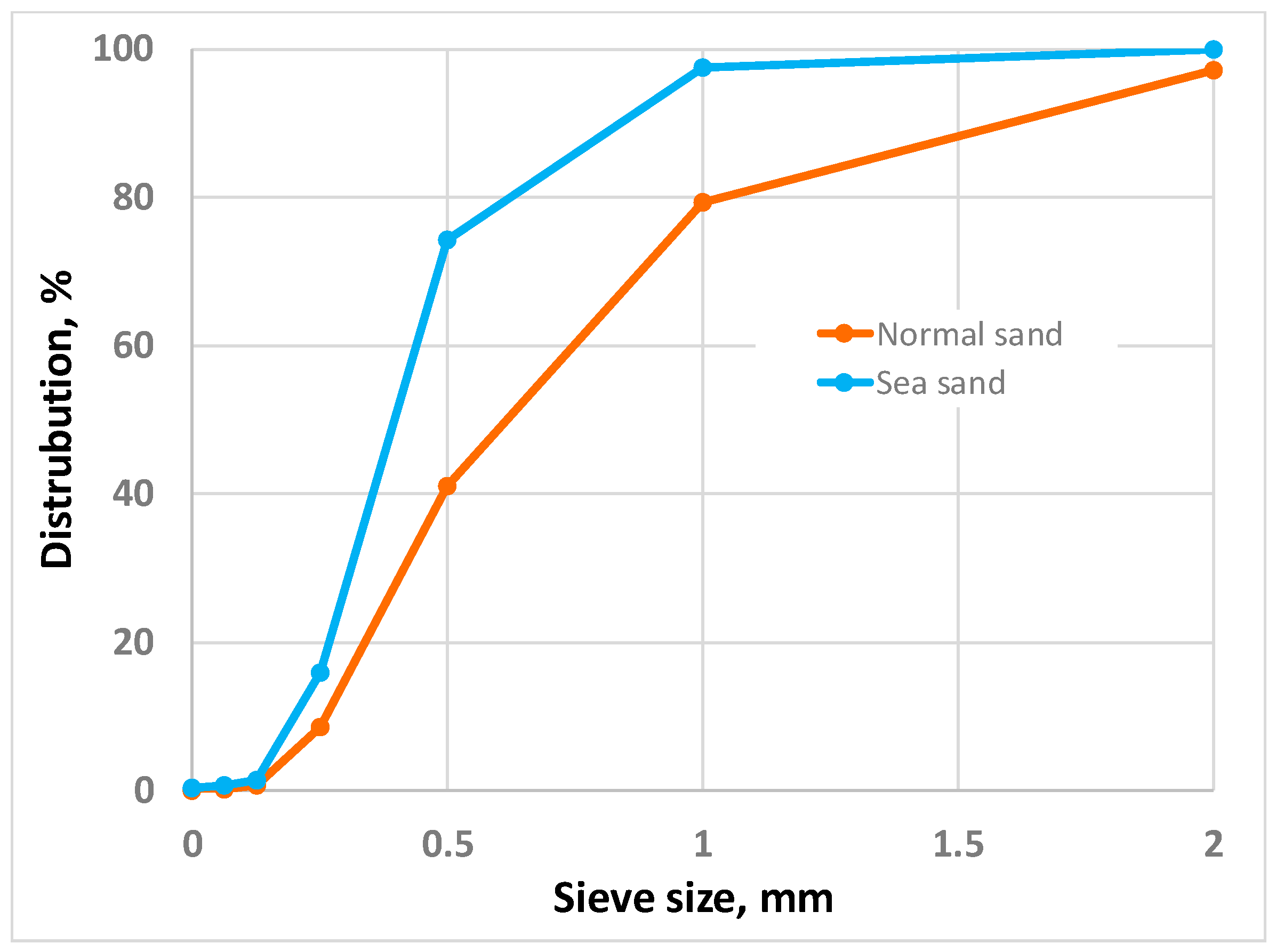
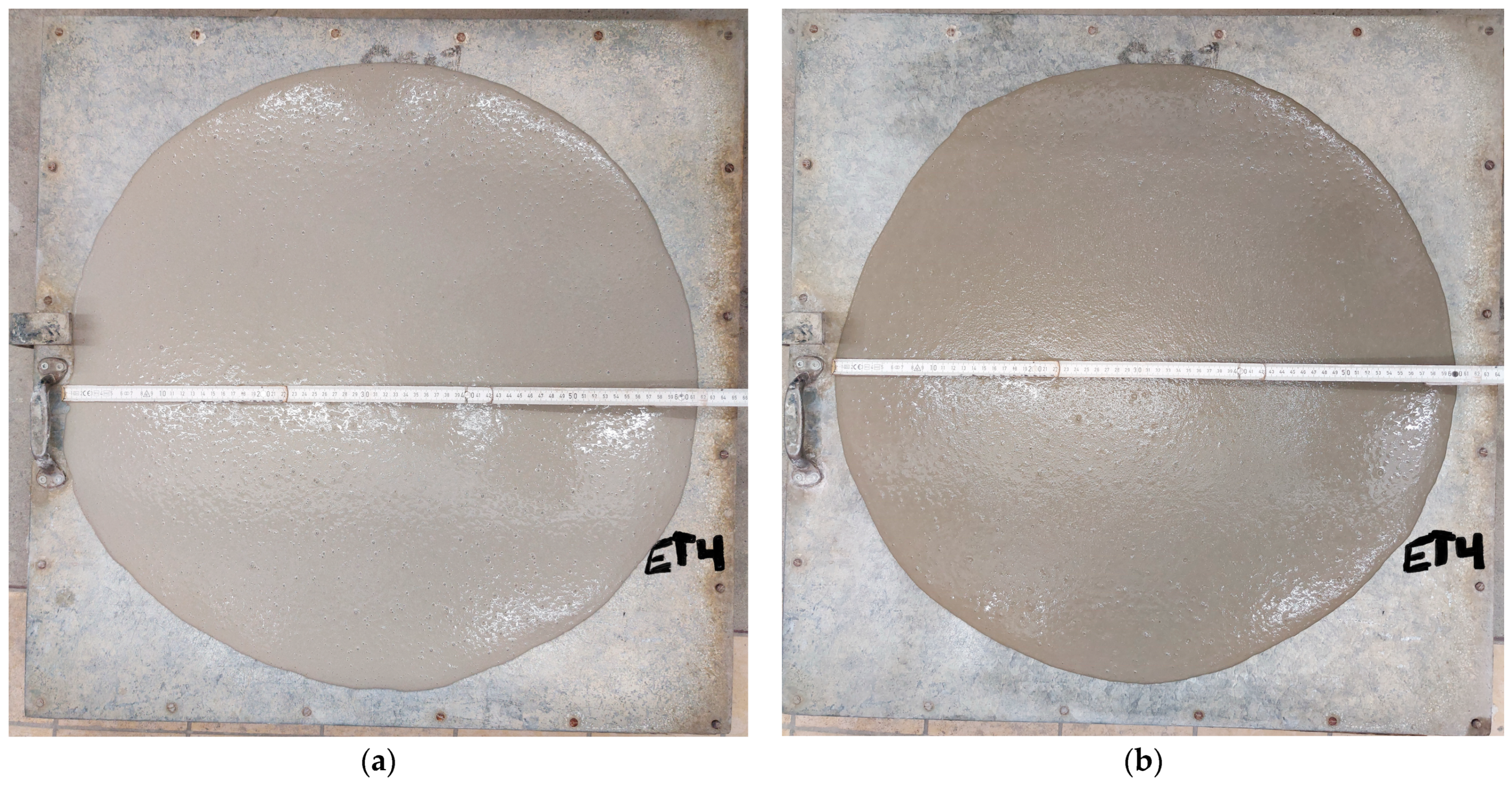
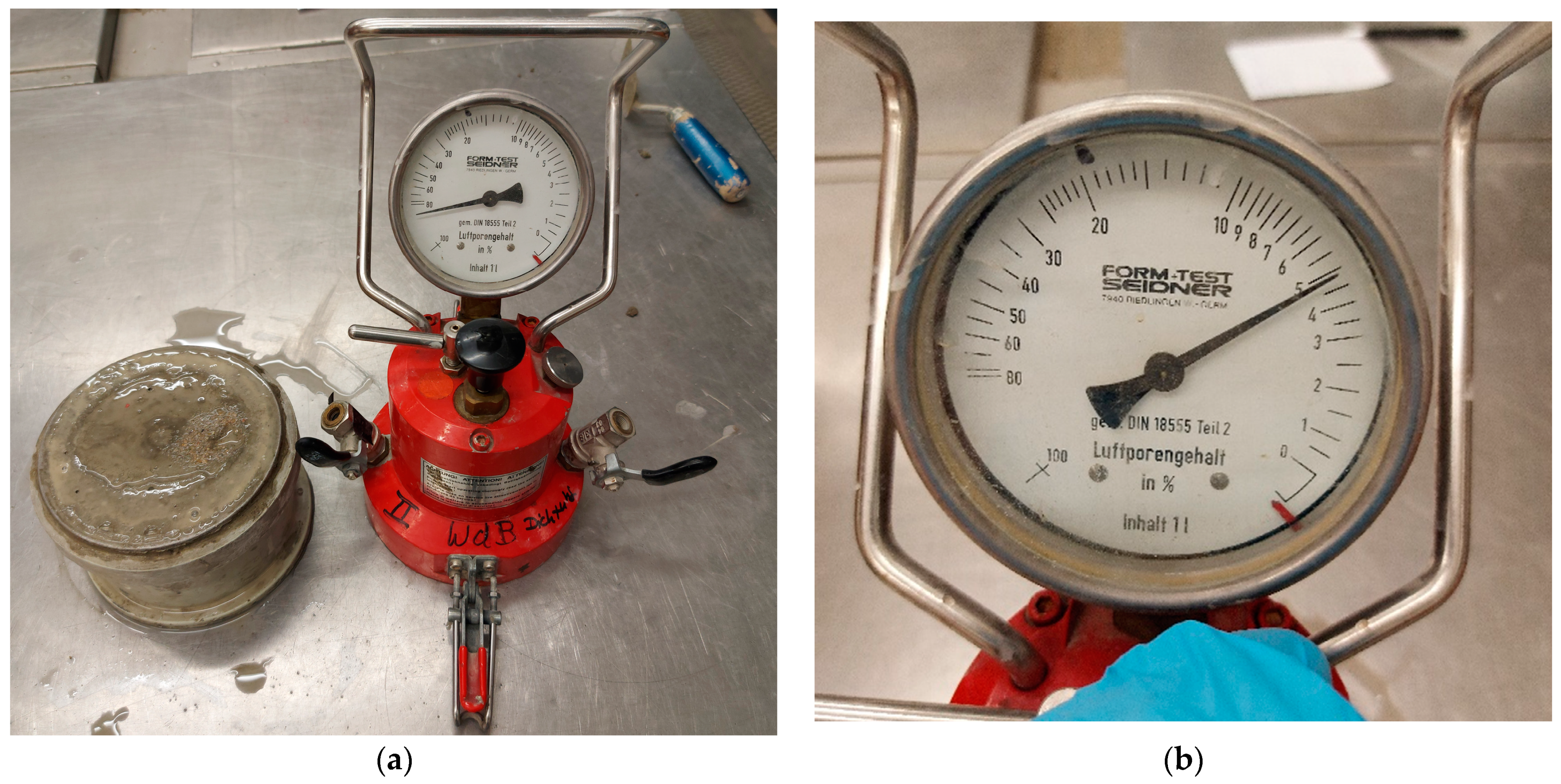
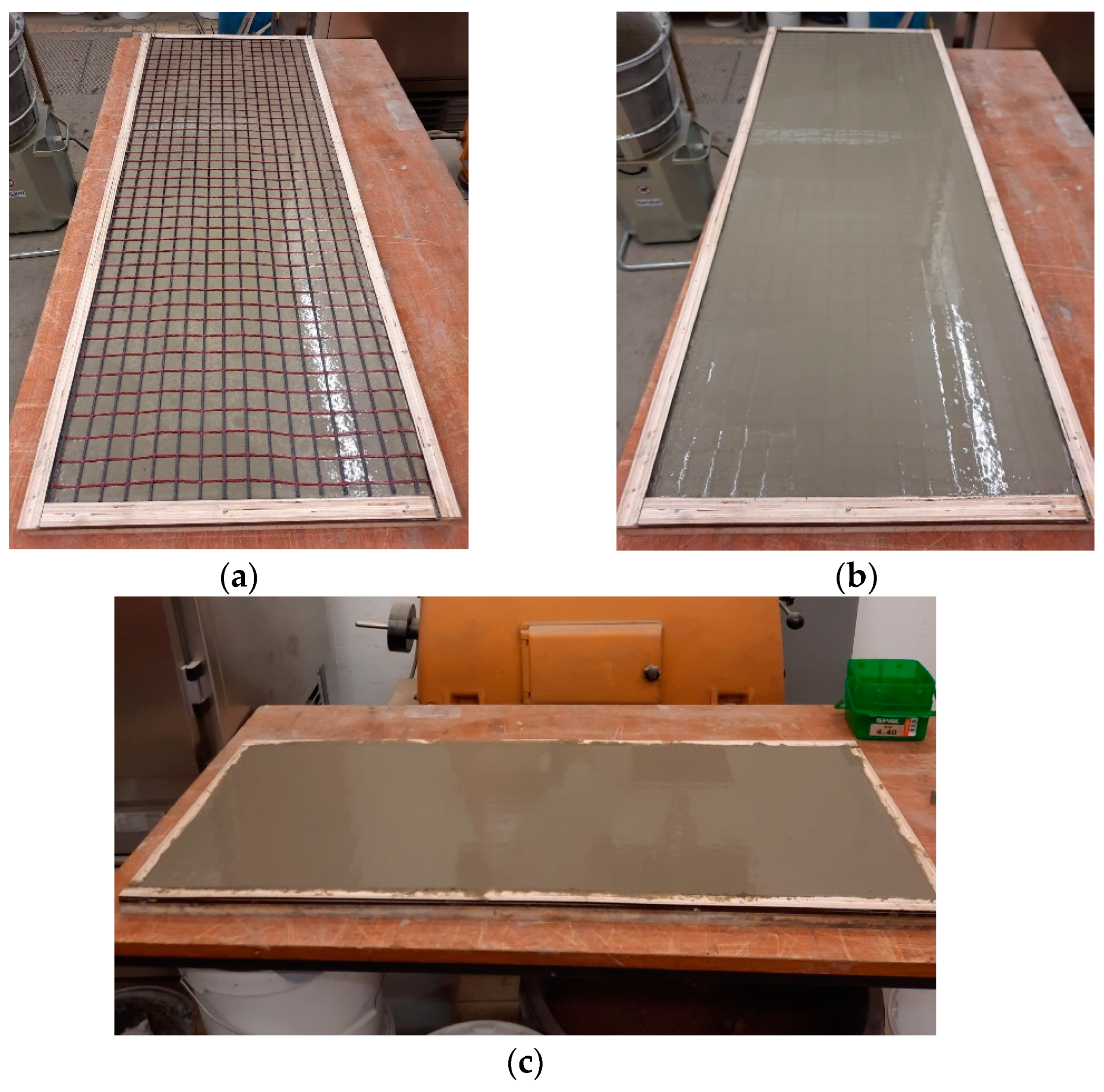

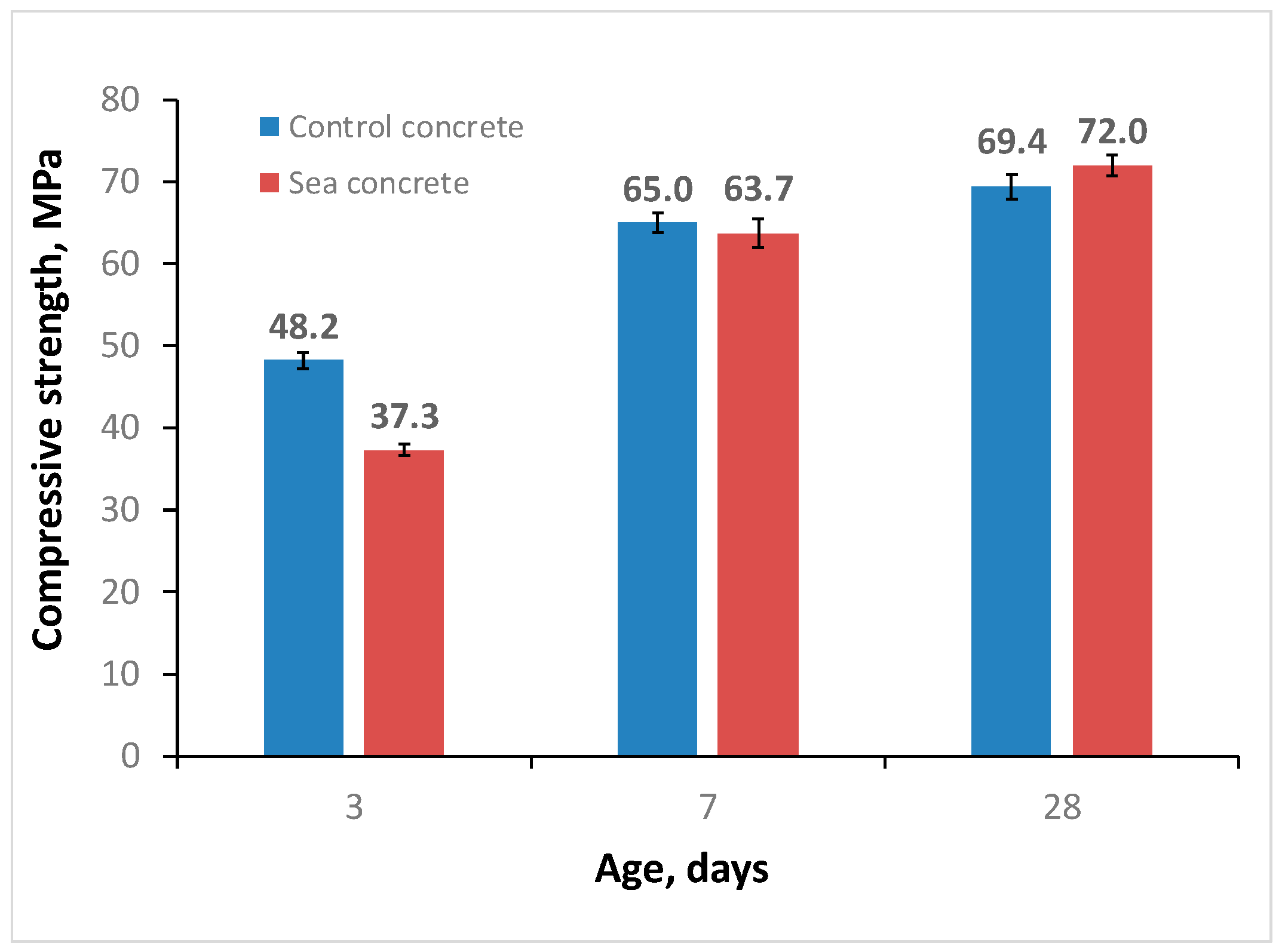
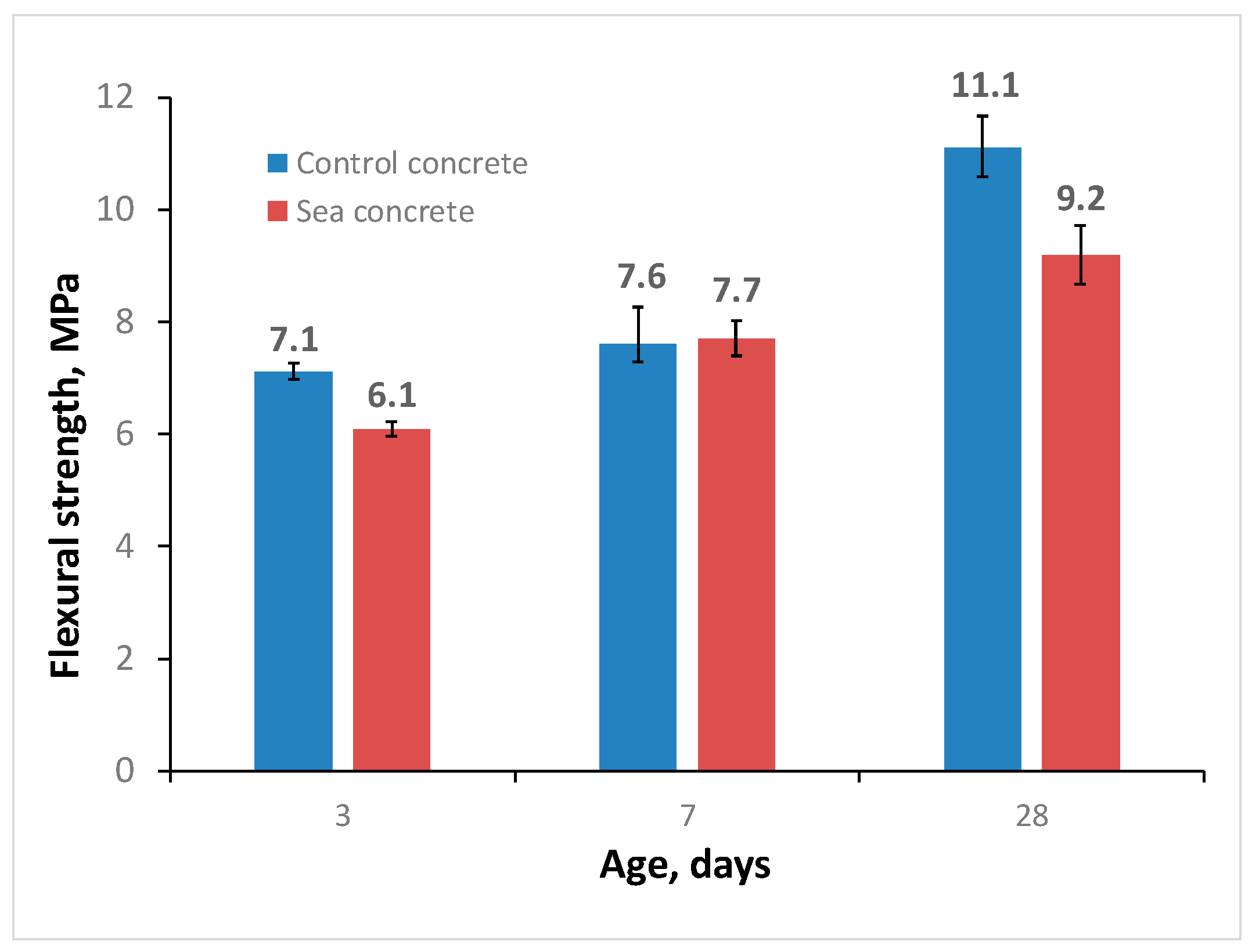
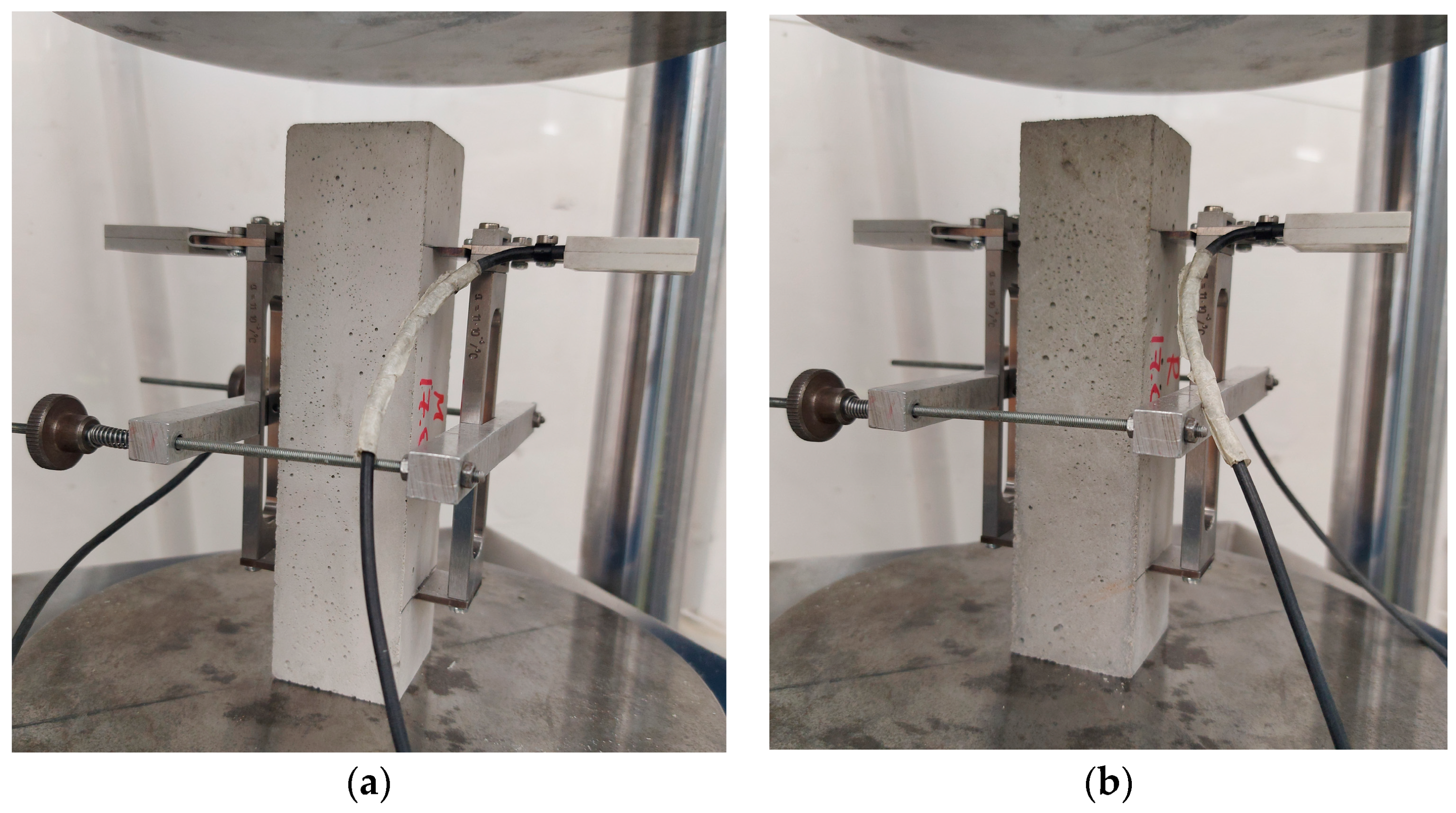
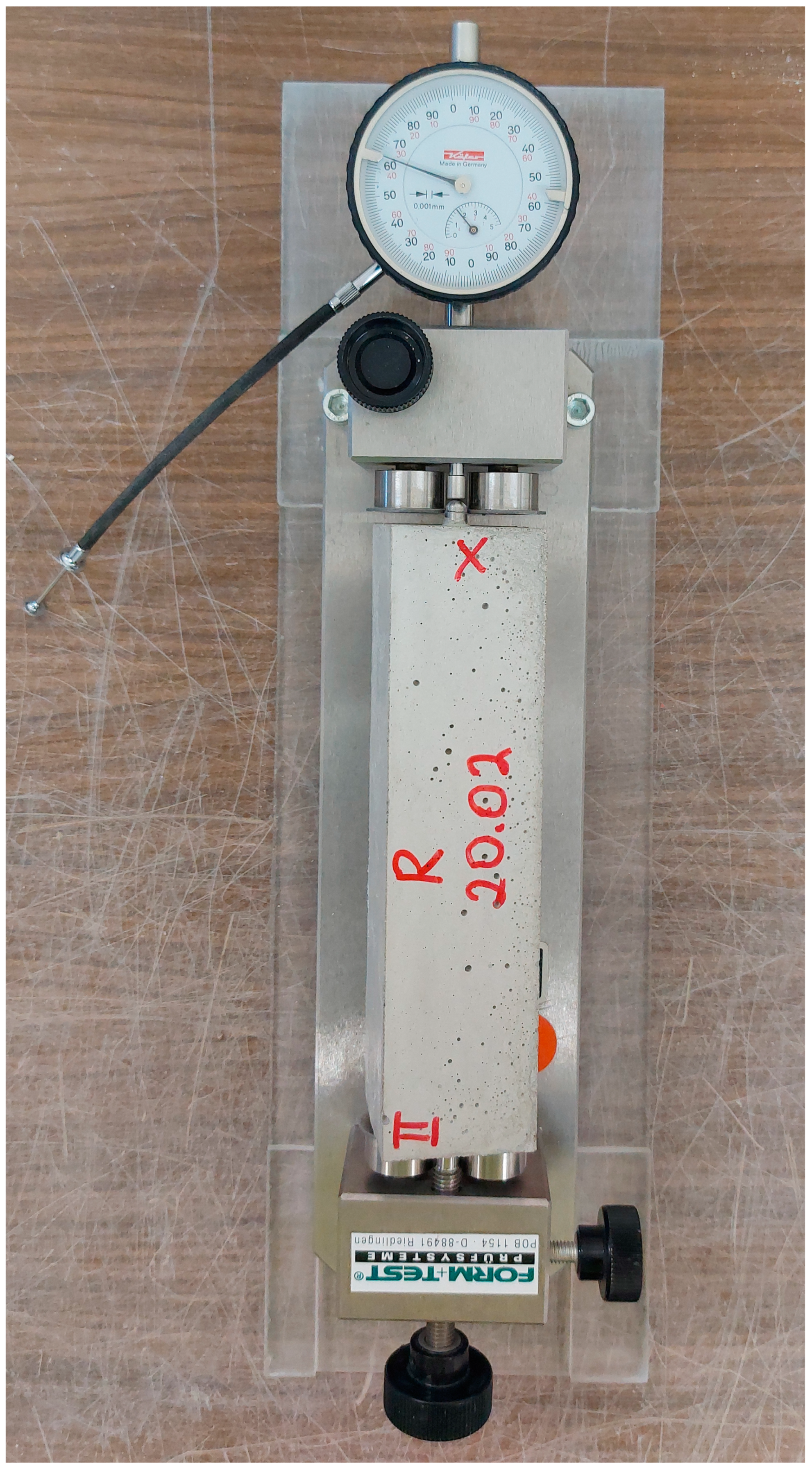
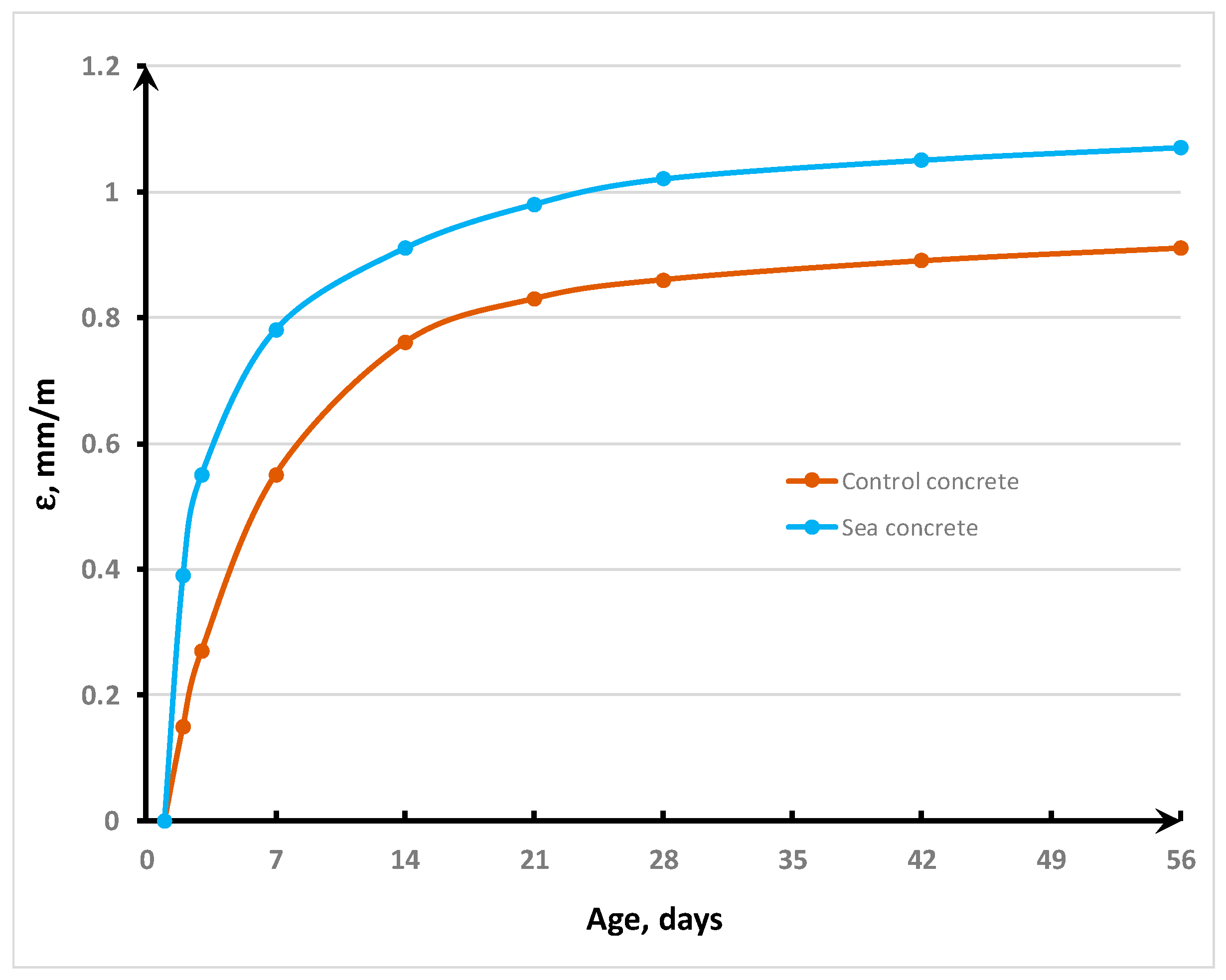

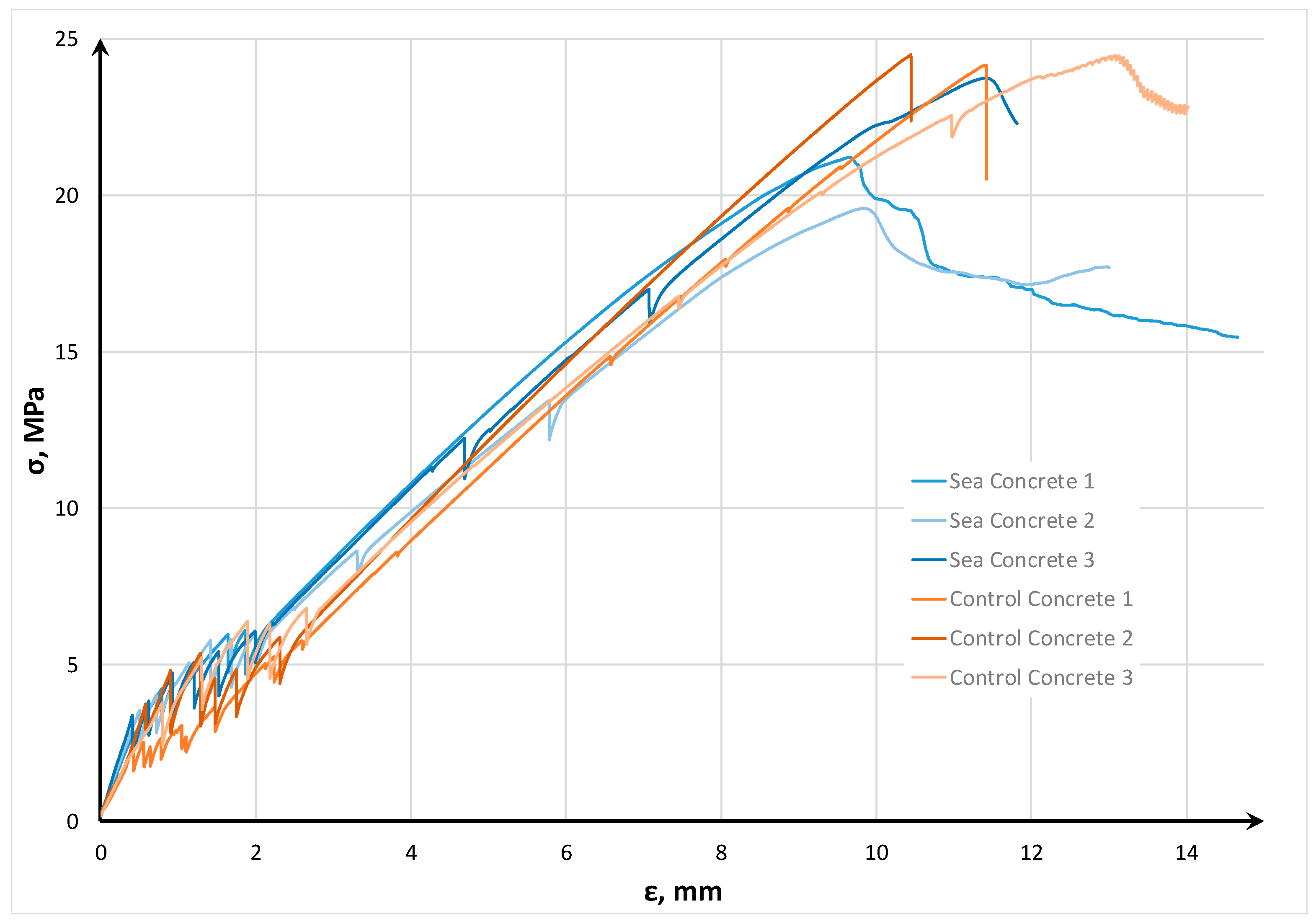
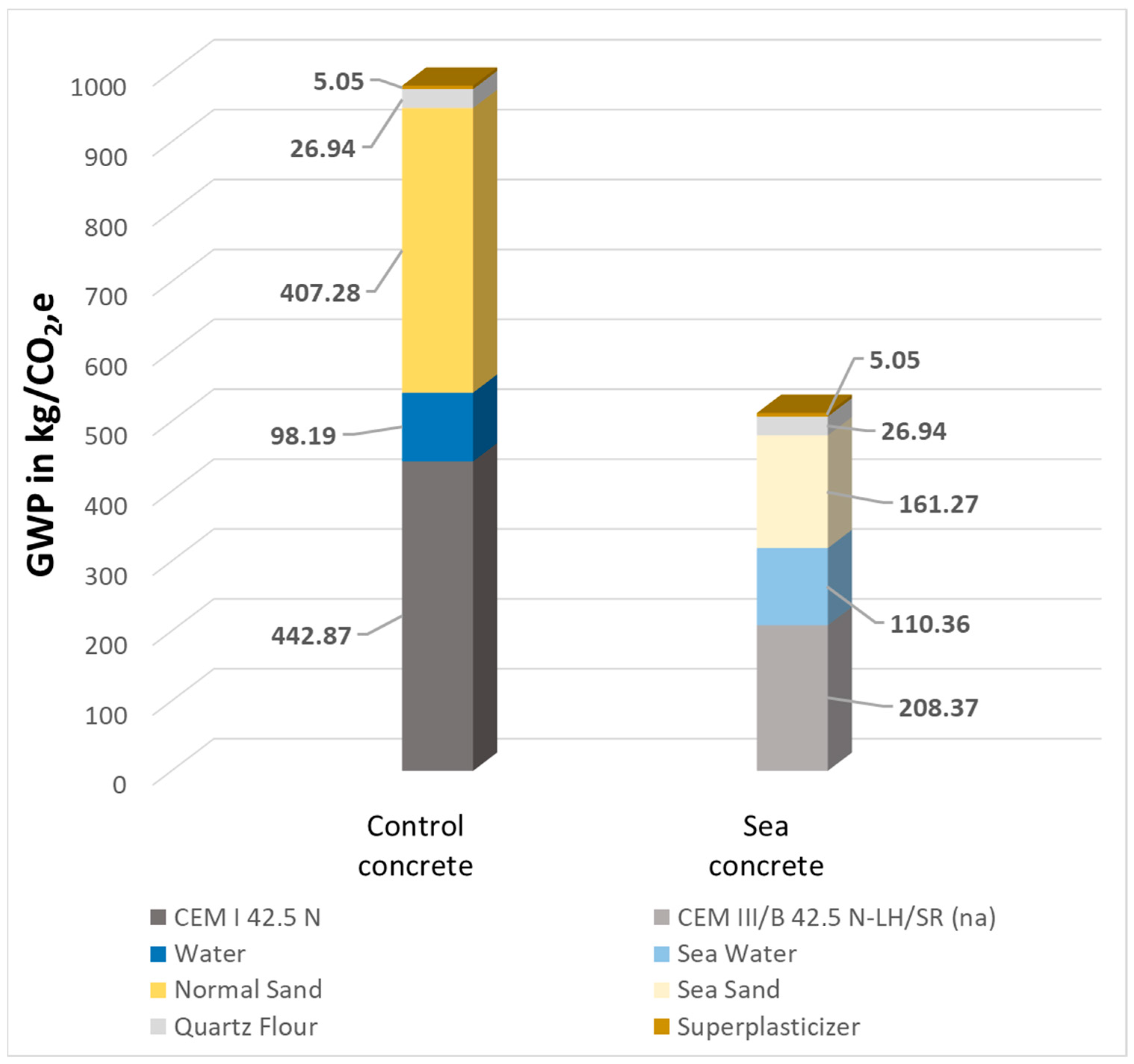
| GWP in kg CO2,e/kg | |
|---|---|
| Carbon Dioxide (CO2) | 1 |
| CEM I 32.5 (Portland cement) | 0.664 |
| CEM I 42.5 (Portland cement) | 0.797 |
| CEM I 52.5 (Portland cement) | 0.816 |
| CEM II 32.5 (Portland composite cement) | 0.785 |
| CEM II 42.5 (Portland composite cement) | 0.794 |
| CEM II 52.5 (Portland composite cement) | 0.807 |
| CEM II/A | 0.874 |
| CEM II/B | 0.718 |
| CEM III 42.5 (GBFS) | 0.386 |
| CEM III 52.5 (GBFS) | 0.399 |
| CEM III/B 42.5-LH/SR | 0.281 |
| CEM IV 32.5 (Pozzolan cement) | 0.674 |
| CEM IV 42.5 (Pozzolan cement) | 0.685 |
| Reference average cement (indicative) | 0.553 |
| Fly ash (with allocation) | 0.350 |
| Granulated blast furnace slag (with allocation) | 0.114 |
| Volcanic ash | 0.026 |
| Calcinated clay | 0.125 |
| Silica dust | 0.028 |
| Sand Type | Bulk Density, kg/m3 | Water Absorption, % |
|---|---|---|
| Normal sand | 1590 | 2.58 |
| Sea sand | 1510 | 3.51 |
| Mixture | Cement, kg/m3 | Normal Sand, kg/m3 | Sea Sand, kg/m3 | Quartz Flour, kg/m3 | Superplasticizer, kg/m3 | Water, kg/m3 | Sea Water, kg/m3 | W/C |
|---|---|---|---|---|---|---|---|---|
| Control concrete | 670 | 1284 | - | 224 | 3.3 | 268 | - | 0.4 |
| Sea concrete | - | 1284 | 3.58 | - | 268 |
| Mixture | Slump Slow, mm | Density, kg/m3 | Air Content, % |
|---|---|---|---|
| Control concrete | 610 | 2315 | 4.8 |
| Sea concrete | 620 | 2305 | 4.6 |
Disclaimer/Publisher’s Note: The statements, opinions and data contained in all publications are solely those of the individual author(s) and contributor(s) and not of MDPI and/or the editor(s). MDPI and/or the editor(s) disclaim responsibility for any injury to people or property resulting from any ideas, methods, instructions or products referred to in the content. |
© 2023 by the authors. Licensee MDPI, Basel, Switzerland. This article is an open access article distributed under the terms and conditions of the Creative Commons Attribution (CC BY) license (https://creativecommons.org/licenses/by/4.0/).
Share and Cite
Kryzhanovskyi, V.; Avramidou, A.; Orlowsky, J.; Spyridis, P. Self-Compacting High-Strength Textile-Reinforced Concrete Using Sea Sand and Sea Water. Materials 2023, 16, 4934. https://doi.org/10.3390/ma16144934
Kryzhanovskyi V, Avramidou A, Orlowsky J, Spyridis P. Self-Compacting High-Strength Textile-Reinforced Concrete Using Sea Sand and Sea Water. Materials. 2023; 16(14):4934. https://doi.org/10.3390/ma16144934
Chicago/Turabian StyleKryzhanovskyi, Vitalii, Athanasia Avramidou, Jeanette Orlowsky, and Panagiotis Spyridis. 2023. "Self-Compacting High-Strength Textile-Reinforced Concrete Using Sea Sand and Sea Water" Materials 16, no. 14: 4934. https://doi.org/10.3390/ma16144934
APA StyleKryzhanovskyi, V., Avramidou, A., Orlowsky, J., & Spyridis, P. (2023). Self-Compacting High-Strength Textile-Reinforced Concrete Using Sea Sand and Sea Water. Materials, 16(14), 4934. https://doi.org/10.3390/ma16144934








